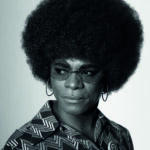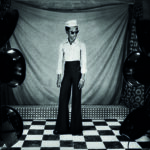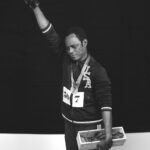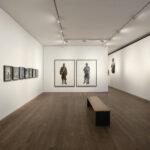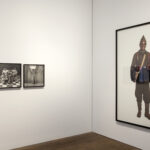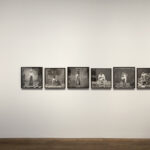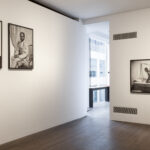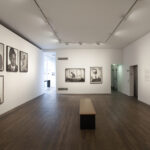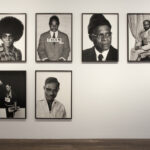London calling | chapter 7
Samuel Fosso
Deutsche Börse Photography Foundation Prize 2023
ITA (English below)
Alla Photographers’ Gallery di Londra si è conclusa la rassegna riguardante i finalisti del Deutsche Börse Photography Foundation Prize 2023, con il premio finale assegnato al fotografo Samuel Fosso. Dai primi autoritratti ai più recenti lavori attraverso i quali l’artista nigeriano impersona e interpreta svariati personaggi, la mostra esamina la carriera di uno degli artisti contemporanei più rilevanti dell’Africa centrale.
Quella di Samuel Fosso (1962) è una carriera abbastanza singolare nel panorama artistico contemporaneo: iniziato alla fotografia quando era pressappoco che un adolescente, diviene un nome di rilievo solo nel 1994, quando il curatore della prima Biennale di Bamako (Mali), Bernard Descamps, rimase colpito dalla personalità espressa negli autoritratti dello sconosciuto fotografo professionale.
Le foto ammirate da Descamps, appartenenti alla serie 70’s Lifestyle (1974-78), ritraggono il giovane Samuel Fosso all’interno dello Studio Photo Nationale, uno studio fotografico aperto dall’artista all’età di tredici anni nella città di Bangui, capitale della Repubblica Centrafricana: a metà tra il tono inquisitorio e lo spirito giocoso, il giovane fotografo si ritrae in diverse posizioni e abiti, creando delle immagini, che nel corso del tempo, hanno assunto una dimensione iconica, prendendo posto tra i grandi maestri della fotografia africana, quali Malick Sidibé, Seydou Keïta, Mama Casset tra gli altri.
Proprio con l’esposizione di alcuni degli autoritratti appartenenti alla serie 70’s Lifestyle, si è aperta l’edizione 2023 del Deutsche Börse Photography Foundation Prize, premio instaurato alla Photographers’ Gallery nel 1996, con l’intento di premiare l’artista che nell’anno passato ha dato un contributo significativo alla fotografia; oltre a Fosso, gli altri finalisti in gara erano: Bieke Depoorter (1986), Arthur Jafa (1960) and Frida Orupabo (1986).
Nel caso di Samuel Fosso, la candidatura alla rassegna finale è avvenuta per la mostra Samuel Fosso tenutasi alla Maison Européenne de la Photographie di Parigi tra il 10 Novembre 2021 e il 13 Marzo 2022. Per quanto riguarda l’assegnazione del premio invece, l’artista nigeriano è stato scelto per la:
“Sua continua esplorazione dell’autoritratto”, la quale, “utilizza un approccio tradizionale, basato sullo studio, intriso di storia, mentre allo stesso tempo il suo lavoro rimane rilevante e affronta le questioni politiche contemporanee di oggi con umorismo e autenticità. Il suo lavoro ha creato una piattaforma straordinaria per voci e artisti neri nel corso della sua carriera”.
È lo stesso artista che rimarca la necessità della (auto) rappresentazione come argomento principale per le sue opere: “Non mi occupo del politico. Ciò che cerco è la pace. Voglio che siamo uguali; neri e bianchi. Voglio essere la voce di chi non ha voce”.
Tale affermazione aiuta a comprendere non solo l’approccio che l’artista instaura con il mezzo fotografico, ma anche l’elemento chiave delle sue rappresentazioni: piuttosto che dal politico, infatti, i lavori di Fosso (soprattutto i primi) prendono spunto molto dal biografico, dalla propria vita ed esperienza personale.
Per esempio, ritornando alla serie 70’s Lifestyle, l’artista ha più volte sottolineato come avesse realizzato tali foto per rassicurare sua nonna della propria condizione, dato che si era trasferito insieme allo zio a Bangui; in aggiunta di ciò, l’artista afferma che il privilegiare gli autoritratti era un modo per riconnettersi alla sua storia biografica, in particolare alla sua infanzia, periodo di cui non esistono fotografie per via di una paralisi che lo avevo colpito da bambino:
Quando mi chiedi perché privilegio gli autoritratti, credo che la risposta derivi dalla condizione della mia vita, e il significato di auto-rappresentazione… Realizzarli mi ha dato l’opportunità di confrontarmi con la mia biografia: tornare a quando ero un bambino, quando nessuno pensava che fossi un bambino desiderabile da fotografare.
Ciò che si avverte nelle fotografie di Fosso è questo rapporto quasi ossessivo tra l’artista e la fotocamera, un rapporto che si rivela attraverso la necessità di osservarsi e il desiderio di ricreare diversi ‘Io’ tramite l’obiettivo fotografico; nelle foto di Fosso, allo stesso modo come per lo spazio, il quale è uno solo, e cioè lo studio fotografico, il soggetto è l’artista stesso, ora intento all’auto ritrattistica, ora alla interpretazione di svariati personaggi, storici e/o creati dalla sua fantasia.
Tali interpretazioni si trovano nelle due foto esposte di Memoire d’un ami (2000), tra le più enigmatiche opere realizzate da Fosso. In questa serie, il fotografo interpreta un amico ucciso da alcune milizie nel 1997 a Bangui, creando nove fotografie che lo ritraggono nei diversi ambienti di una casa nudo e spaventato, come se consapevole e in attesa di una minaccia esterna. Tra queste, le foto che ritraggono l’artista sul letto, rimandano a un soggetto classico dell’arte occidentale, e cioè quello dell’odalisca: come altri fotografi a lui contemporaneo, come ad esempio Rotimi Fani-Kayode (1955-1989), il soggetto dell’odalisca non viene solo citato, ma ribaltato.
Assieme alle foto di Memoire d’un ami, sono stati esposti alcuni dei lavori appartenenti alla serie African Spirits (2008), la quale ha segnato un importante sviluppo nella carriera di Fosso: in African Spirits, infatti, il fotografo si cimenta nella personificazione di personaggi africani e afroamericani simboli della lotta per i diritti umani, quali Martin Luther King, Angela Davis, l’imperatore etiope Haile Selassie e artisti vari, tra cui Miles Davis e Seydou Keïta. Alla base di questi ritratti, Fosso ha posto la necessità di rivelare storie e personaggi nascosti rivendicando il suo ruolo di artista:
“Se gli artisti non prendono vantaggio di questa opportunità, la schiavitù,
la storia dei neri non verrà mai raccontata…Sono un artista. Sono molto conosciuto.
Ora spetta a me di rivelare coloro che sono nascosti”.
I ritratti in bianco e nero di African Spirits pongono le interpretazioni di Fosso su un piano diverso rispetto alle precedenti le quali erano concentrate ora sull’esplorazione della propria identità e vita personale, ora su una critica ed esplorazione di tipi sociali (come, ad esempio, la serie Tati – 1997): con African Spirits, e i lavori successivi, Fosso pone sé stesso all’interno della storia e come portavoce di una collettività, dimostrando l’incredibile capacità dell’artista di ricrearsi e di recepire gli eventi storici del proprio tempo.
* * *
ENG
At the Photographers’ Gallery in London, the review of the finalists of the Deutsche Börse Photography Foundation Prize 2023 has concluded, with the final prize awarded to the photographer Samuel Fosso. From the first self-portraits to the most recent works through which the Nigerian artist personifies and interprets various characters, the exhibition examines the career of one of Central Africa’s most relevant contemporary artists.
That of Samuel Fosso (1962) is a rather singular career in the contemporary art scene: having started photography when he was more or less a teenager, he only became a prominent name in 1994, when the curator of the first Biennial of Bamako (Mali), Bernard Descamps, was struck by the personality expressed in the self-portraits of the unknown professional photographer.
The photos admired by Descamps, belonging to the 70’s Lifestyle (1974-78) series, portray the young Samuel Fosso inside the Studio Photo Nationale, a photographic studio opened by the artist himself at the age of thirteen in the city of Bangui, Central African Republic: halfway between inquisitive tone and playful spirit, the young photographer portrays himself in different positions and clothes. Over time, these early works by Fosso have taken on an iconic dimension, taking their place among the great masters of African photography, such as Malick Sidibé, Seydou Keïta, Mama Casset, among others.
The Deutsche Börse Photography Foundation Prize 2023, an award established at the Photographers’ Gallery in 1996, with the intention of rewarding the artist who past made significant contributions to photography, opened precisely with the exhibition of some of the self-portraits belonging to the 70’s Lifestyle series; besides Fosso, the other finalists in the competition were: Bieke Depoorter (1986), Arthur Jafa (1960) and Frida Orupabo (1986).
In the case of Samuel Fosso, the candidacy for the final review took place for the exhibition Samuel Fosso held at the Maison Européenne de la Photographie in Paris between 10 November 2021 and 13 March 2022. As for the awarding of the prize instead, the Nigerian artist was chosen for:
“His sustained exploration of self-portraiture”, which, “uses a traditional, studio-based approach steeped in history, while at the same time his work remains relevant and addresses contemporary political issues of today with humour and authenticity. His work has created an extraordinary platform for Black voices and artists throughout his career.”
It is the artist himself who underlines the need for (self) representation as the main argument for his works: “I don’t do political. What I seek is peace. I want us to be equal; black and white. I want to be the voice of the voiceless“.
This statement helps to understand not only the approach that the artist establishes with the photographic medium, but also the key element of his representations: rather than from the political, in fact, Fosso’s works (particularly the first ones) take their cue from the biographical, from his own life and personal experience.
For example, returning to the 70’s Lifestyle series, the artist has repeatedly underlined how he had made these photos to reassure his grandmother of his condition, given that he had moved with his uncle to Bangui, the capital of the Central African Republic; in addition to this, the artist states that favouring self-portraits was a way to reconnect to his biographical history, in particular to his childhood, a period of which there are no photographs due to a paralysis that had struck him as a child:
“When you ask me why I favor self-portraits, I think the answer comes from the condition of my life, and the meaning of self-representation…Making them gave me the opportunity to confront my own biography: going back to when I was a child, when nobody thought I was a desirable child to photograph”.
What is felt in Fosso’s photographs is this almost obsessive relationship between the artist and the camera, a relationship that is revealed through the need to observe oneself and the desire to recreate different ‘I’s through the photographic lens; in Fosso’s photos, in the same way as for the space, which is only one, and that is the photographic studio, the subject is the artist himself, now intent on self-portraiture, now on the interpretation of various characters, historical and/ or created by his imagination.
These interpretations can be found in the two exhibited photos of Memoire d’un ami (2000), among the most enigmatic works created by Fosso. In this series, the photographer plays a friend killed by some militias in 1997 in Bangui, creating nine photographs that portray him naked and frightened in the different rooms of a house, as if aware and waiting for an external threat. Among these, the photos that portray the artist on the bed refer to a classic subject of Western art, namely that of the odalisque: like other contemporary photographers, such as Rotimi Fani-Kayode (1955-1989), the subject of the odalisque is not only mentioned, but overturned.
Alongside the photos of Memoire d’un ami, some of the works belonging to the African Spirits (2008) series were exhibited, which marked a further development in Fosso’s interpretations: in African Spirits, in fact, the photographer engages in the personification of African and African American personalities who are symbols of the struggle for human rights, such as Martin Luther King, Angela Davis, the Ethiopian emperor Haile Selassie and various artists, such as Miles Davis and Seydou Keïta. At the basis of these portraits, Fosso has placed the need to reveal hidden stories and characters, and to do this he claims his role as an artist:
“If artists don’t take advantage of this opportunity, slavery,
the black story will never be told…I’m an artist. I am well known.
Now it is up to me to reveal those who are hidden”.
The black and white portraits of African Spirits place Fosso’s interpretations on a different plane than the previous ones which were now focused on the exploration of one’s own identity and personal life, now on a critique and exploration of social types (such as, for example , the Tati series – 1997): with African Spirits, and subsequent works, Fosso places himself within history and as the spokesman of a community, demonstrating the artist’s incredible ability to recreate himself and to embrace the historical events of his time.

